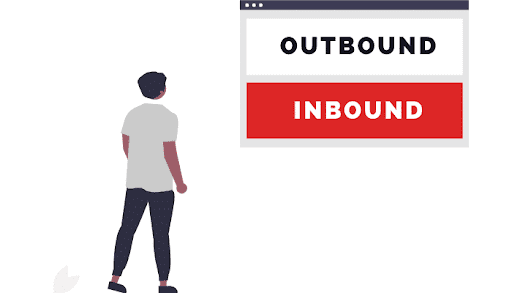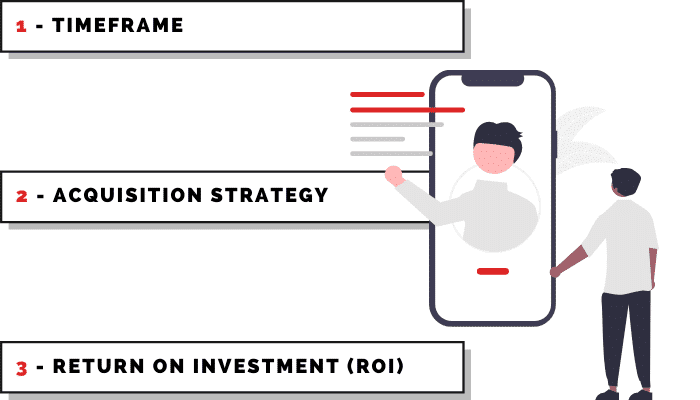Sales Process Explained | The Key Differences Between Inbound and Outbound Sales
Uncover the key differences between inbound and outbound sales approaches, and gain insights into their unique strategies, tools, and tactics to empower your sales success.

Jul 19, 2023
As you embark on your journey to understanding the realm of sales, one question is likely at the forefront of your mind: what is the difference between inbound and outbound sales? These two key approaches shape the way businesses reach their customers, and as a potential salesperson, understanding their intricacies can greatly influence your career trajectory.
In the world of sales, you may find a fondness for outbound sales amongst many professionals. The allure? The power to direct the sales process and the prospect of swift revenue generation. On the flip side, marketers might sing praises for inbound sales, valuing its scalability, cost-effectiveness, and its charm in attracting customers.
Yet, the choice isn't about picking a winner. Instead, it's about understanding where you fit in this broad landscape and how these methods align with your skills and aspirations. This post is designed to help you demystify these two sales approaches, understand their distinctive advantages, and, hopefully, illuminate which path could be the right one for you.
Inbound vs Outbound Sales: A 30,000ft View
At its core, the difference between inbound and outbound sales lies in the way a SaaS company acquires its customers. Either the customer initiates contact with the company or vice versa.
Inbound Sales
With inbound sales, a customer would directly approach a SaaS company to buy their product and/or service. This means that the company needs to have the right strategies in place to attract these customers.
Ultimately, the goal is to sell a product and/or solution to help customers solve a problem. The following process is illustrated in 4 steps:
The customer first makes contact with the company and shows an interest in their product and/or service.
The company then aims to convert these customers into leads through some kind of form or lead capture device such as 'Sign-Up'
To build additional interest, they’ll push the prospect through a nurture program; showing how they provide realistic and appropriate solutions to the customer's problems.
Finally, after building trust and interest, the relationships might have progressed to the point where they reach out to an SDR to complete a sale.
Outbound Sales
In contrast, with outbound sales, the company, usually through a sales rep, will initiate contact with the customer. From there, the steps are a bit different
The sales rep will nurture the prospect before attempting to sell their product and/or service. This approach is more aggressive in nature and takes more effort as well as resources. In summary, this approach is based on a companies ability to build a relationship with customers that they know they can sell too.
On this end, the process is the opposite. A company would instead actively search and reach out to their customers:
The company would spend a bit more time identifying their potential customers and once they have identified their customers,
Their outbound sales team or a BDR will typically reach out, qualify and,
Then attempt to convert them into leads. During this time, they would also demonstrate the benefits of their products and/or services to close the deal.
The key differences
Once we dig a little deeper, there are several other key differences in the strategies companies will use and how quickly they can see results.
1 - Timeframe
Inbound Sales
Inbound sales rely on a more organic approach to attract customers. As such, it typically takes longer for inbound sales results to show and for leads to be generated. High-level marketing content and strategies need to be developed by companies in order to effectively employ this method.
Examples being, content that would allow them to create brand awareness and make it easy for their audience to find them. Don't forget, this takes time to develop and implement.
Outbound Sales
Outbound sales in comparison are capable of showing results faster. To quantify, outbound sales campaigns can typically deliver results in a matter of days or weeks. As sales representatives will actively reach out to identified customers directly. This speed runs the lead generation process, pushing the sales process.
More resources and effort are needed during this process in order to successfully identify, qualify, and pursue customers. In today's digital world, sales tools has made outbound sales much easier. It is a multi-million dollar industry with tons of tech companies building the tools sales teams need to do better in outbound sales.
Examples of some great tools to help with outbound sales:
HubSpot
SalesLoft
InsideSales.com
Witty Parrot
InsideView
2 - Acquisition Strategy
Inbound Sales
A more passive approach to customer acquisition, inbound sales teams will typically interact heavily with the marketing team in order to achieve their organic reach. Here are some sales and marketing methods inbound sales teams would rely heavily on:
Optimizing their websites - using online forms, chatbots, and developing resources.
Content marketing - based on information relevant to the product and/or service they offer.
Blogs and guest blogging - to raise their credibility as leaders in their space.
Search Engine Optimization (SEO) - to rank higher on searchers and association with certain keywords relevant to their product and/or service.
Social Media - a new modern wonder that has helped many businesses reach a large audience easily, quickly, and efficiently.
Public relations outreach and promotions - collaborations with other brands and companies to help develop association and raise brand awareness.
Paid Advertising - if you’re working for a young company. Chances are there is a fair reliance on paid ads.
Outbound Sales
A more active approach to selling, outbound sales strategies vary from inbound. Their strategies are about reaching their potential customer directly to offer their products and/or services. Imagine already knowing who needs your product and/or service, so all you've got to do next is introduce yourself! Here are some of the methods they opt for:
Email marketing - similar to a modern flier, but helps your potential lead contact you easier.
Cold calling - say hello to your potential customer and have a conversation with them.
Social selling - social media, but make it DMs.
Landing pages - custom pages with all the information your potential lead may need.
Targeted advertisements - FaceBook got into a lot of trouble over this, but professional outbound salespeople know how to find information respectfully and ethically.
Trade shows - an excellent place to gain exposure and build connections with potential leads.
3 - Return on Investment (ROI)
So, which method has a better return on investment (ROI)? Honestly? It depends on the specific company, industry, target customer, as well as the products and/or service offered.
Inbound Sales
While inbound sales puts the control over the sale in the hands of the customer, they are very effective for certain products and/or services. For example, inbound sales are far more effective for selling SaaS products compared to outbound sales.
A problem to be aware of regarding the ROI of inbound sales is that it can be challenging to measure. The reason being, marketers just don’t know what they did to persuade a customer to buy a product! But this doesn't mean you can't track progress. There are a ton of tools available for you to use to track your progress!
Outbound Sales
For products with lengthy purchase decisions and higher prices like vehicles and properties - they tend to perform better with the outbound sales method. Building a strong relationship between both parties is important when selling products that are of high cost and commitment.
Outbound sales has very specific goals with timelines and a number of tools that can help them accurately track their progress. As a result, their ROI is much easier to calculate and track.
Wait, what is the significance of ROI? Well, if companies are unable to effectively measure ROI, they won’t have the insights necessary to improve their sales strategies.
So, which is the right approach?
Well... here's the thing, you don’t need to choose. You are free to use both strategies in the most effective method! Enjoy the benefits of both approaches following what type of products and/or services you provide.
For example, a company can use inbound marketing techniques to generate leads. They can then use outbound approaches to qualify those leads and close the deals. Another example where it’s helpful to use both approaches is when a company does not have enough inbound leads. They can then engage in outbound sales strategies to generate more leads.
Anyhow, the point is, you don't have to choose! Many companies use both approaches simultaneously to reach their customers, grow their sales pipeline, and ultimately, generate more revenue.
The Bottom Line
As we've explored, the distinct approaches of inbound and outbound sales each come with their own set of benefits and strategies. The choice between them depends on your unique aspirations and style as a sales professional.
But this is just the beginning of your journey in tech sales, and it's a path you don't have to navigate alone. With Uvaro's Premium membership, you gain access to a comprehensive catalog of resources designed to equip you with the knowledge and tools you need to excel in your sales career.
Whether you're building your dream sales team from scratch or seeking to hone your existing skills, Uvaro is here to support you every step of the way. Our tailored courses and workshops can accelerate your understanding and implementation of sales strategies, ensuring you make the most of your talents.
Ready to embark on your tech sales journey? Join the Uvaro community. Your future in tech sales starts here.




